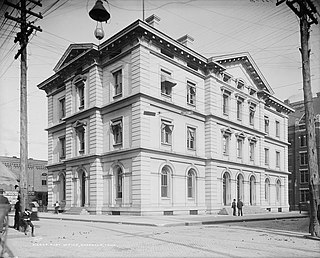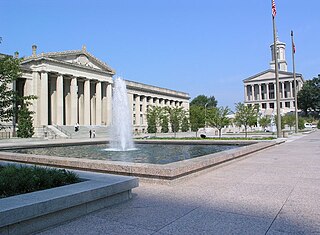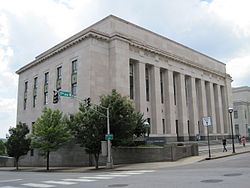
The Tennessee State Capitol, located in Nashville, Tennessee, is the seat of government for the U.S. state of Tennessee. It serves as the home of both houses of the Tennessee General Assembly–the Tennessee House of Representatives and the Tennessee Senate–and also contains the governor's office. Designed by architect William Strickland (1788–1854) of Philadelphia and Nashville, it was built between 1845 and 1859 and is one of Nashville's most prominent examples of Greek Revival architecture. The building, one of 12 state capitols that does not have a dome, was added to the National Register of Historic Places in 1970 and named a National Historic Landmark in 1971. The tomb of James K. Polk, the 11th president of the United States, is on the capitol grounds.

Marr & Holman was an architectural firm in Nashville, Tennessee known for their traditional design. Notable buildings include the Nashville Post Office and the Milliken Memorial Community House in Elkton, Kentucky.

The Indiana Statehouse is the state capitol building of the U.S. state of Indiana. It houses the Indiana General Assembly, the office of the Governor of Indiana, the Indiana Supreme Court, and other state officials. The Statehouse is located in the capital city of Indianapolis at 200 West Washington Street. Built in 1888, it is the fifth building to house the state government.

The North Carolina State Capitol is the former seat of the legislature of the U.S. state of North Carolina which housed all of the state's government until 1888. The Supreme Court and State Library moved into a separate building in 1888, and the General Assembly moved into the State Legislative Building in 1963. Today, the governor and his immediate staff occupy offices on the first floor of the Capitol.

The Capitol of Puerto Rico is located on the Islet of San Juan just outside the walls of Old San Juan. The building is home to the bicameral Legislative Assembly, composed of the House of Representatives and Senate. The building is located in the Puerta de Tierra sector of San Juan. It was built between 1921 and 1929.

The Blount Mansion, also known as William Blount Mansion, located at 200 West Hill Avenue in downtown Knoxville, Tennessee, was the home of the only territorial governor of the Southwest Territory, William Blount (1749–1800). Blount, a Founding Father of the United States, a signer of the United States Constitution, and a U.S. Senator from Tennessee, lived on the property with his family and ten African-American slaves. The mansion served as the de facto capitol of the Southwest Territory. In 1796, much of the Tennessee Constitution was drafted in Governor Blount's office at the mansion. Tennessee state historian John Trotwood Moore once called Blount Mansion "the most important historical spot in Tennessee."

The Old Customs House, also called the Old Post Office, is a historic building located at the corner of Clinch Avenue and Market Street in Knoxville, Tennessee, United States. Completed in 1874, it was the city's first federal building. It housed the federal courts, excise offices and post office until 1933. From 1936 to 1976, it was used by the Tennessee Valley Authority for offices. Expanded in 2004, the building is home to the East Tennessee History Center, which includes the Lawson McGhee Library's Calvin M. McClung Historical Collection, the Knox County Archives, and the East Tennessee Historical Society's headquarters and museum. The building is listed on the National Register of Historic Places for its architectural significance.
This is a list of the National Register of Historic Places listings in Knox County, Tennessee.

The Knox County Courthouse is a historic building located at 300 Main Street in Knoxville, Tennessee, United States. Built in 1886, it served as Knox County's courthouse until the completion of the City-County Building in 1980, and continues to house offices for several county departments. John Sevier, Tennessee's first governor, is buried on the courthouse lawn. The courthouse is listed on the National Register of Historic Places for its architecture and its role in the county's political history.

The Cherokee National Capitol, now the Cherokee Nation Courthouse, is a historic tribal government building in Tahlequah, Oklahoma. Completed in 1869, it served as the capitol building of the Cherokee Nation from 1869 to 1907, when Oklahoma became a state. It now serves as the site of the tribal supreme court and judicial branch. It was designated a National Historic Landmark in 1961 for its role in the Nation's history.

District of Columbia City Hall, also known as "Old City Hall" and the "District of Columbia Courthouse", is a historic building at Judiciary Square in downtown Washington, D.C. facing Indiana Avenue. Originally built for the offices of the government of the District of Columbia, the District's courthouse was subsequently used as a Federal courthouse, and was the scene of several notable criminal trials including those of three accused presidential assassins. The building was declared a National Historic Landmark in 1960. It now houses the District of Columbia Court of Appeals.

Tennessee marble is a type of crystalline limestone found only in East Tennessee, in the southeastern United States. Long esteemed by architects and builders for its pinkish-gray color and the ease with which it is polished, this stone has been used in the construction of numerous notable buildings and monuments throughout the United States and Canada, including the National Gallery of Art and the National Air and Space Museum in Washington, D.C., the Minnesota State Capitol, as well as parts of the United States Capitol in Washington, Grand Central Terminal in New York, and Union Station in Toronto. Tennessee marble achieved such popularity in the late-19th century that Knoxville, the stone's primary finishing and distribution center, became known as "The Marble City."

There are 75 properties listed on the National Register of Historic Places in Albany, New York, United States. Six are additionally designated as National Historic Landmarks (NHLs), the most of any city in the state after New York City. Another 14 are historic districts, for which 20 of the listings are also contributing properties. Two properties, both buildings, that had been listed in the past but have since been demolished have been delisted; one building that is also no longer extant remains listed.

The Daylight Building or Daylight Block is a two-story office and commercial building on Union Avenue in downtown Knoxville, Tennessee. The building was completed in 1927. It is listed on the National Register of Historic Places.

The War Memorial Auditorium is a 2,000-seat performance hall located in Nashville, Tennessee. Built in 1925, it served as home of the Grand Ole Opry between 1939 and 1943. It is also known as the War Memorial Building, the Tennessee War Memorial, or simply the War Memorial. It is located across the street from, and is governed by, the Tennessee Performing Arts Center, and is also adjacent to the Tennessee State Capitol. It received an architectural award at the time of its construction, and was listed on the National Register of Historic Places in 2017.

St. Mary of the Seven Sorrows Church is an historic Catholic parish in downtown Nashville, Tennessee, United States. Its church on the corner of Charlotte Avenue and 5th Avenue in Nashville, Tennessee, built in 1845, it is the oldest extant church in Nashville and the oldest Catholic church in what is now the Diocese of Nashville. St. Mary replaced the diocese's first church, Holy Rosary, which had been erected previously on the site today occupied by the Tennessee State Capitol.

The United States Post Office and Courthouse, commonly called the Knoxville Post Office, is a state building located at 501 Main Street in Knoxville, Tennessee, United States. Constructed in 1934 for use as a post office and federal courthouse, the building contains numerous Art Deco and Moderne elements, and is clad in Tennessee marble. While the building is still used as a branch post office, the court section is now used by the state courts. The building is listed on the National Register of Historic Places for its architecture and political significance.
McKissack & McKissack is an American design, program management and construction firm based in New York. It is the oldest Black-owned architecture and construction company in the United States.

Hugh Cathcart Thompson (1829–1919) was an American architect from Tennessee.

The Estes Kefauver Federal Building & Courthouse Annex is a Federal office building and a courthouse of the United States District Court for the Middle District of Tennessee built in Nashville, Tennessee in 1952. The nine-story annex to the building was completed in 1974.




















